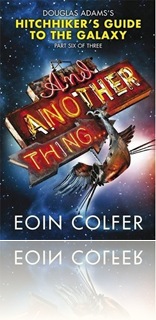Book review: And Another Thing… by Eoin Colfer
 Douglas Adams was one of the most influential authors of the 20th century. Though probably best known for his five part trilogy, The Hitchhiker’s Guide to the Galaxy, which exists as a radio series (produced over the span of a couple of decades), a television series, records, books and a movie, and a couple of books about Dirk Gently, he also wrote for Doctor Who and Monty Python. In addition to the fiction and comedy genres, he also wrote Last Chance to See, which looks at some of the most endangered species in the world. He also founded The Digital Village which morphed into h2g2, an online community modeled after the Guide in THHGTTG. Sadly, he died of a heart attack in 2001, while in the middle of his next book.
Douglas Adams was one of the most influential authors of the 20th century. Though probably best known for his five part trilogy, The Hitchhiker’s Guide to the Galaxy, which exists as a radio series (produced over the span of a couple of decades), a television series, records, books and a movie, and a couple of books about Dirk Gently, he also wrote for Doctor Who and Monty Python. In addition to the fiction and comedy genres, he also wrote Last Chance to See, which looks at some of the most endangered species in the world. He also founded The Digital Village which morphed into h2g2, an online community modeled after the Guide in THHGTTG. Sadly, he died of a heart attack in 2001, while in the middle of his next book.
This is not that book.
(That book is The Salmon of Doubt, the first half of which is based on what he’d written so far and then several essays by his contemporaries.)
This book is And Another Thing… by Eoin Colfer.
Picking up sometime after the end of Mostly Harmless, And Another Thing… was written by Eoin Colfer and published by Penguin Books to celebrate the thirtieth anniversary of the publication of the first book of the famous trilogy in five parts.
Reintroducing us to Arthur Dent, Ford Prefect, Trillian Astra, Random Dent (Arthur’ and Trillian’s daughter), Wowbagger the Infinitely Prolonged, Thor, and, of course, the Vogons. There’s also an irritating computer and a large slab of Cheese.
By the end of Mostly Harmless, we had learned that the Vogons (among others) were behind the creation of the Guide Mk II, the next generation of the Hitchhiker’s Guide To The Galaxy. Mk II’s mission to once and for all eliminate the Earth, a task the Vogons had found to be annoyingly complicated. The story left off with the Earth being blown up, again. Pretty final and an ending that I must admit I really didn’t like that much, probably because of its finality.
And Another Thing… opens with us learning that the Earth wasn’t quite blown up (again), yet – that was scheduled to happen about five minutes later. The story proceeds with our heroes escaping (or that would have been a very short story indeed) and eventually making their way to a colony of refugees from Earth on a small planet called Nano located on the other side of the galaxy. Along the way they encounter Wowbagger the Infinitely Prolonged and Zaphod. Thor enters the picture at about this point and there’s a showdown of immortals with surprising results. The story ends with Arthur once again experiencing the consequences of a being from a Plural Zone (Earth is/was in galactic zone ZZ9 Plural Z Alpha) travelling in hyperspace.
(I’m not sure I like the ending of this story, either.)
Douglas Adams had a very distinctive style of writing. The description of “space” from The Hitchhiker’s Guide To The Galaxy is classic Douglas Adams:
Space is big. Really big. You won’t believe how vastly, hugely, mind-bogglingly big it is. I mean, you may think it’s a long way down the road to the chemist’s, but that’s just peanuts to space.
There’s an elegant rhythm and style to the writing that other authors have tried to mimic, often unsuccessfully. Eoin Colfer drew on elements from the five books in the trilogy such as people, places and things mentioned in passing, and incorporated them into his novel. Unfortunately, while they often felt familiar, they tended to feel a little forced at the same time. But, they were nonetheless in the spirit of the Guide.
So, at the end of the day, if you’re a fan of Douglas Adams and first five books in The Hitchhiker’s Guide To The Galaxy trilogy you’ll probably want to read this book. If you haven’t read any of the other books in the series, or you’re not a big Douglas Adams fan, this book probably isn’t for you.



 AKA Keeper of Maps, I'm a geocacher who lives in Ottawa, Canada.
AKA Keeper of Maps, I'm a geocacher who lives in Ottawa, Canada.
